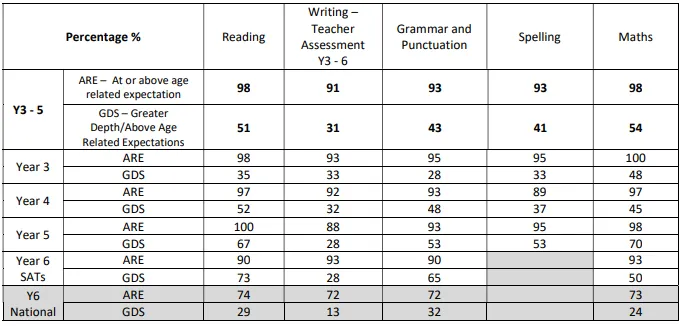Assessment Reporting
Following parental feedback last year we are providing parents with additional information to help you understand your child’s results. In late November your child took NFER tests in Reading, Punctuation and Grammar, Spelling and Maths. We are now able to share with you the results along with their writing teacher assessments. Understanding standardised scores is not always easy and sadly not all standardised scores are the same; we are hoping to clarify what these results mean to you and your child.
We have widened our assessment categories so you can see progress over time and will be conducting NFER tests in the spring and summer terms as well so by the end of each year there will be three terms of data.
This year we have made the decision to use standardised scores as opposed to age standardised scores which we have previously measured. It is therefore not possible to make direct comparisons with results from previous years but we have conducted analysis of previous results and the variations tend to be around 2-3 marks so these should not be dramatically different.
Understanding standardised scores
Standardised scores enable us to confidently make comparisons with large national samples of test takers.
With NFER Tests, each test has been standardised in the term in which it is intended to be used, so autumn tests have been standardised in the autumn term, spring tests in the spring term and summer tests in the summer term. A standardised score of 100 represents the average score of all the pupils participating in that standardisation. Therefore a pupil achieving a standardised score of 100 is performing in line with the national average for that term. If the same pupil achieves a standardised score of 100 on a consecutive test, this shows they are performing consistently at an average level i.e. they are retaining a similar position relative to the national average. A pupil who consistently gains a similar standardised score is making average or expected progress in line with the progress seen nationally.
If a pupil’s standardised score goes up significantly, it means they are making more than average progress. Conversely, if a pupil’s standardised score falls significantly, they are making less than average progress and may need to be monitored more carefully.
Pupils take the test and receive a raw score based on the number of points achieved in the test which may comprise of more than one paper; e.g. the maths test consists of a mental arithmetic paper and two other maths papers therefore three papers in total. These scores are then converted to a standardised score.
|
Standardised score |
|
|
|
Below 70 |
Much below average |
WTS |
|
70 - 84 |
Below average |
WTS + |
|
85 - 94 |
Low average |
EXS - |
|
95 - 105 |
Average |
EXS |
|
106 – 115 |
High average |
EXS + |
|
116 – 130 |
Above average |
GDS |
|
131+ |
Much above average |
GDS + |
We recognise that not all pupils thrive in ‘test conditions’ and the results of testing may not always reflect a child’s true ability. As teachers, we make teacher assessments on an ongoing basis and whilst we recognise that testing is not always enjoyable, we do feel that it is essential to allow pupils to become more accustomed to test conditions so they are ready and comfortable prior to formal testing in Year 6 and beyond.
Whole School Assessment Results

Page updated July 2025















